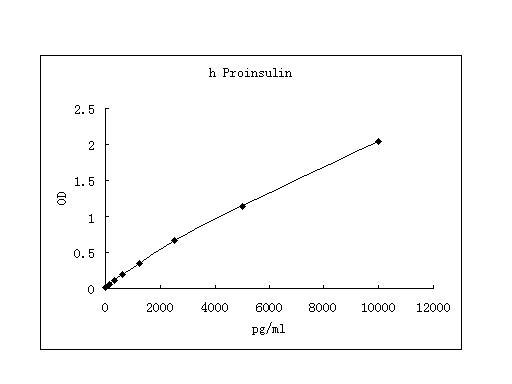Detect Range: 156.25-10000pg/ml
Sensitivity: 70pg/mL
Sample Type: Cell culture supernatant, serum, plasma (EDTA, citrate, heparin)
Sample Volume: 20 uL
Assay Time: 3 hours
Detection method: Colorimetric

Proinsulin is synthesized as a single chain, 110 amino acid (aa) preproprecursor that contains a 24 aa signal sequence and an 86 aa proinsulin propeptide. Following removal of the signal peptide, the proinsulin peptide undergoes further proteolysis to generate mature insulin, a 51 aa disulfidelinked dimer that consists of a 30 aa B chain (aa 2554) bound to a 21 aa A chain (aa 90110). The 34 aa intervening peptide (aa 5589)that connects the B and A chains is termed the Cpeptide.
Human proinsulin shares 84% and 80% aa sequence identity with rat and bovine proinsulin, respectively. Most of the sequence variation between species occurs in the region of the Cpeptide(1). This peptide generates a structural conformation that allows for the correct formation of the intrachain disulphide bonds (1). Insulin is a molecule that facilitates the cellular uptake of glucose. This is accomplished by regulating the appearance of membrane glucose transporters. Low insulin levels or lack of insulin are associated with type 2 and type 1 diabetes mellitus, respectively. These conditions are associated with an increased risk for microvascular complications such as retinopathy, nephropathy, and peripheral neuropathy (3). Proinsulin also circulates, but its physiologic role is less well understood. It does possess about 25% of the activity of mature insulin, but it would seem unlikely to be a natural substitute for insulin (4). In type 2 diabetes, an elevated proinsulin to insulin ratio in the circulation is a well known abnormality (59). Perhaps this abnormality represents either compromised proteolytic processing or a general inability to process increased levels of insulin precursor (5). In any event, proinsulin will stimulate amylin secretion by βcells, and amyloid formation in pancreatic islets that promotes decreased β cell function (10). Studies also suggest that fasting serum proinsulin may be a better predictor of future type 2 diabetes than fasting insulin levels in obese children (11).
Bell, G.I. et al. (1980) Nature 284:26.
Barbetti, F. et al. (1990) J. Clin. Endocrinol. Metab. 71:164.
Forst, T. et al. (2008) Exp. Diabetes Res. 2008:176245.
Steffes, M.W. et al. (2003) Diabetes Care 26:832.
Roder, M.E. et al. (1999) Diabetes Care 22:609.
Porte, D. Jr. (1991) Diabetes 40:166.
Gordon, P. et al. (1974) Diabetologia 34:483.
Saad, M.F. et al. (1990) J. Clin. Endocrinol. Metab. 70:1247.
Roder, M.E. et al. (1995) J. Clin. Endocrinol. Metab. 80:2359.
Dworacka, M. et al. (2006) Int. J. Clin. Pharmacol. Ther. 44:14.
Kamoda, T. et al. (2006) Diabetes Obes. Metab. 8:192.
My Review
© 2017, AbSci All Rights Reserved. E-mail: info@abscitech.com
南京川博生物技术有限公司版权所有
苏B1-20150380 苏ICP备15009006号-1